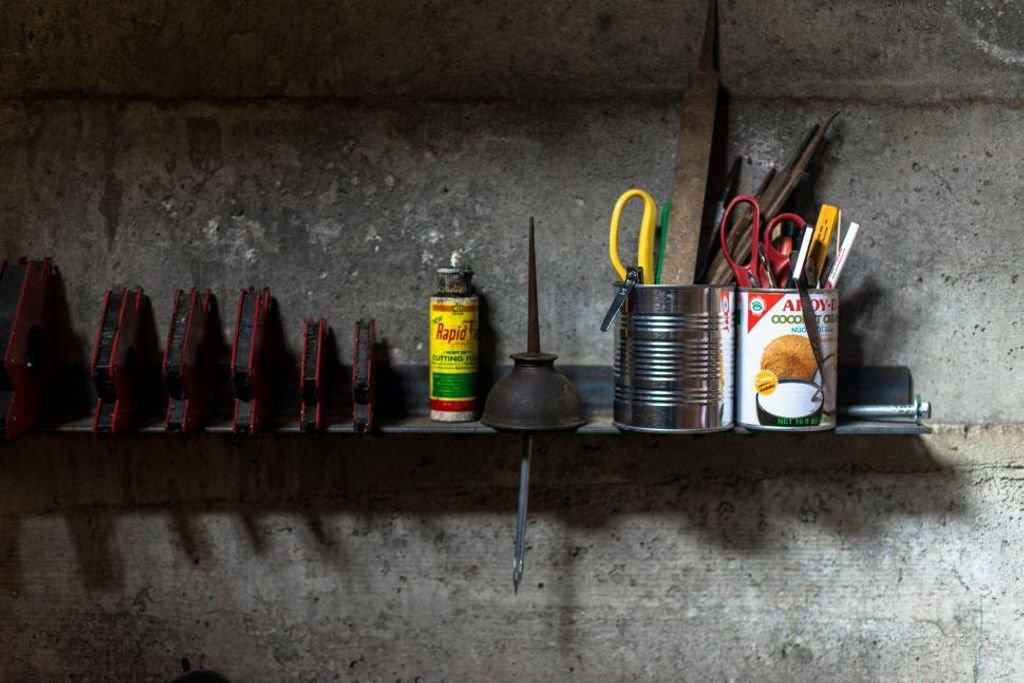Being a DIY car enthusiast requires having the right tools for the job. Whether you’re performing routine maintenance or tackling more complex repairs, having a well-equipped toolbox is essential. In this article, we will discuss the top 5 tools that every DIY car enthusiast needs to have in their arsenal.
Key Takeaways
- Mechanic’s Tool Set
- Diagnostic Scanner
- Floor Jack and Jack Stands
- Air Compressor
- Torque Wrench
Mechanic’s Tool Set
Socket Set
A socket set is an essential tool for any DIY car enthusiast. It consists of a variety of sockets in different sizes, along with a ratchet handle. With a socket set, you can easily tighten or loosen bolts and nuts of various sizes. It provides a secure grip and allows for precise torque application.
Using a socket set is straightforward. Simply select the appropriate socket size, attach it to the ratchet handle, and place it over the bolt or nut. Then, turn the handle in the desired direction to tighten or loosen the fastener.
Here are some common socket sizes found in a socket set:
| Socket Size | Common Uses |
|---|---|
| 1/4 inch | Small bolts and nuts |
| 3/8 inch | Medium-sized bolts and nuts |
| 1/2 inch | Large bolts and nuts |
Remember to always use the correct socket size to avoid damaging the fastener or the socket itself.
Tip: It’s a good idea to invest in a high-quality socket set that includes both metric and standard sizes, as different car models may use different measurement systems.
Wrench Set
A wrench set is an essential tool for any DIY car enthusiast. It allows you to tighten or loosen bolts and nuts with ease. Whether you’re working on your car’s engine or performing routine maintenance, a good quality wrench set will come in handy.
Versatility – A wrench set typically includes a variety of sizes and types of wrenches, such as open-end wrenches, box-end wrenches, and combination wrenches. This ensures that you have the right tool for any job.
Durability – Look for wrench sets made from high-quality materials like chrome vanadium steel, as they are more durable and less likely to break or strip bolts.
Comfort – Consider wrench sets with ergonomic handles that provide a comfortable grip, reducing hand fatigue during long hours of work.
Organization – Some wrench sets come with a storage case or rack, keeping your tools organized and easily accessible.
In summary, a wrench set is a versatile and essential tool for any DIY car enthusiast. Invest in a high-quality set that offers durability, comfort, and organization for all your automotive projects.
Screwdriver Set
A screwdriver set is an essential tool for any DIY car enthusiast. It allows you to tighten or loosen screws and bolts in various parts of your car. Whether you’re working on the engine, interior, or exterior, a good screwdriver set will come in handy.
When choosing a screwdriver set, look for one that includes a variety of sizes and types of screwdrivers. This will ensure that you have the right tool for any job that comes your way.
Tip: It’s also a good idea to invest in a magnetic screwdriver set. The magnetic tip will help prevent screws from falling and getting lost in hard-to-reach places.
Here are some common types of screwdrivers that you may find in a set:
- Flathead screwdriver: Used for screws with a single slot
- Phillips screwdriver: Used for screws with a cross-shaped slot
- Torx screwdriver: Used for screws with a star-shaped slot
- Hex screwdriver: Used for screws with a hexagonal slot
Having a screwdriver set in your toolbox will make your DIY car projects much easier and more efficient.
Diagnostic Scanner
OBD-II Scanner
An OBD-II scanner is an essential tool for any DIY car enthusiast. It allows you to diagnose and troubleshoot problems with your car’s engine and other systems. With an OBD-II scanner, you can retrieve error codes, view live data, and even perform advanced functions like resetting the check engine light.
One of the key features of an OBD-II scanner is its ability to read and interpret the diagnostic trouble codes (DTCs) generated by your car’s onboard computer. These codes provide valuable information about the specific issue that is causing a malfunction or warning light to appear. By using an OBD-II scanner, you can quickly identify the problem and take appropriate action to fix it.
In addition to reading DTCs, an OBD-II scanner can also display live data from your car’s sensors. This includes information such as engine RPM, coolant temperature, and oxygen sensor readings. By monitoring this data in real-time, you can gain insight into how your car is performing and identify any potential issues before they become major problems.
To use an OBD-II scanner, simply plug it into the OBD-II port in your car, which is usually located under the dashboard. Once connected, you can navigate through the scanner’s menu system to access various functions and features. Some scanners even have built-in diagnostics and repair guides to help you troubleshoot and fix common problems.
Overall, an OBD-II scanner is a must-have tool for any DIY car enthusiast. It provides valuable information and functionality that can help you maintain and repair your car with confidence.
Code Reader
A code reader is an essential tool for any DIY car enthusiast. It allows you to retrieve and interpret the diagnostic trouble codes (DTCs) stored in your vehicle’s onboard computer system. With a code reader, you can quickly identify the cause of a check engine light or other warning lights. By understanding the DTCs, you can diagnose and fix the issue yourself or communicate the problem to a professional mechanic.
Here are some key features and benefits of a code reader:
- Easy to use: Code readers are designed to be user-friendly, with clear instructions and intuitive interfaces.
- Cost-effective: Owning a code reader can save you money by avoiding unnecessary trips to the mechanic for simple diagnostic tasks.
- Time-saving: With a code reader, you can quickly identify the problem and take appropriate action, reducing the time spent troubleshooting.
Tip: Make sure to choose a code reader that is compatible with your vehicle’s make and model for accurate results.
Multimeter
A multimeter is an essential tool for any DIY car enthusiast. It is used to measure electrical voltage, current, and resistance. With a multimeter, you can diagnose electrical issues in your car’s wiring, test the battery voltage, and check the continuity of electrical circuits.
Using a multimeter is relatively simple. Just set the dial to the appropriate measurement range, connect the probes to the circuit or component you want to test, and read the values on the display.
Here are some common uses of a multimeter:
- Testing the voltage of the car battery
- Checking the resistance of spark plug wires
- Verifying the continuity of fuses and relays
Tip: When using a multimeter, always start with the highest measurement range and work your way down to avoid damaging the meter.
It’s important to invest in a quality multimeter that is accurate and reliable. Look for features like auto-ranging, which automatically selects the appropriate measurement range, and a built-in fuse to protect the meter from overload.
Having a multimeter in your toolbox will save you time and money by allowing you to troubleshoot and diagnose electrical problems in your car.
Floor Jack and Jack Stands
Hydraulic Floor Jack
A hydraulic floor jack is an essential tool for any DIY car enthusiast. It provides the necessary lifting power to raise your vehicle off the ground, allowing you to perform various maintenance and repair tasks. With its hydraulic mechanism, you can easily and safely lift heavy vehicles with minimal effort.
When choosing a hydraulic floor jack, it’s important to consider its weight capacity and lifting range. Make sure to select a jack that can handle the weight of your vehicle and has a lifting range suitable for your needs.
Additionally, it’s recommended to use jack stands in conjunction with a hydraulic floor jack for added safety. Jack stands provide extra support and stability, preventing the vehicle from accidentally falling while you work underneath it.
Remember to always follow proper safety precautions when using a hydraulic floor jack and jack stands. This includes placing the jack on a stable and level surface, positioning it correctly under the vehicle’s lifting points, and double-checking that the vehicle is securely lifted before starting any work.
Jack Stands
Jack stands are an essential tool for any DIY car enthusiast. They provide a stable and secure support system for lifting and holding up vehicles during maintenance and repairs. Safety is of utmost importance when working under a car, and using jack stands is crucial to prevent accidents and injuries.
When choosing jack stands, it’s important to consider their weight capacity and height range. Make sure to select jack stands that can safely support the weight of your vehicle and provide enough clearance for the work you need to do.
Here are some key points to keep in mind when using jack stands:
- Always use jack stands on a level and solid surface.
- Place the jack stands at the designated lifting points on the vehicle.
- Double-check that the jack stands are securely locked in place before working under the car.
Remember, never rely solely on a hydraulic jack to support a vehicle. Jack stands are a critical tool for ensuring your safety while working on your car.
Air Compressor
Portable Air Compressor
A portable air compressor is an essential tool for any DIY car enthusiast. It provides a convenient and efficient way to inflate tires, power pneumatic tools, and perform various tasks around the garage or workshop.
One of the key advantages of a portable air compressor is its versatility. It can be used for a wide range of applications, from inflating car tires and sports equipment to powering air tools like impact wrenches and nail guns.
Portability is another important feature of a portable air compressor. It is typically compact and lightweight, making it easy to transport and store. This allows you to take it with you on road trips or to remote locations where access to air is limited.
When choosing a portable air compressor, consider factors such as maximum pressure, airflow rate, and tank capacity. These specifications will determine the compressor’s performance and suitability for different tasks.
To help you make an informed decision, here is a table comparing some popular portable air compressors:
| Model | Maximum Pressure | Airflow Rate | Tank Capacity |
|---|---|---|---|
| A | 150 PSI | 2.6 CFM | 6 gallons |
| B | 120 PSI | 3.2 CFM | 4 gallons |
| C | 135 PSI | 2.8 CFM | 3 gallons |
Remember to choose a portable air compressor that meets your specific needs and budget.
Tip: Regularly check the air compressor’s oil level and clean or replace the air filter to ensure optimal performance and longevity.
Air Impact Wrench
An air impact wrench is a powerful tool that every DIY car enthusiast should have in their arsenal. It is designed to deliver high torque output, making it ideal for loosening and tightening stubborn bolts and nuts. With its pneumatic power source, an air impact wrench provides consistent and reliable performance.
If you frequently work on your car’s suspension, brakes, or wheels, an air impact wrench can greatly speed up the process. It allows you to quickly remove and install lug nuts, saving you time and effort.
When choosing an air impact wrench, consider factors such as the maximum torque, air consumption, and noise level. A higher maximum torque means the wrench can handle tougher jobs, while lower air consumption and noise level contribute to a more comfortable working environment.
Here are some key features to look for in an air impact wrench:
- Maximum torque: Look for a wrench with a high maximum torque rating to handle a wide range of tasks.
- Adjustable power settings: Some wrenches offer adjustable power settings, allowing you to control the torque output for different applications.
- Comfortable grip: A wrench with a comfortable grip will reduce fatigue during extended use.
Tip: Always wear appropriate safety gear, such as safety glasses and gloves, when using an air impact wrench.
Torque Wrench
Click-Type Torque Wrench
A click-type torque wrench is an essential tool for any DIY car enthusiast. It allows you to accurately tighten bolts and nuts to the specified torque value, ensuring that they are neither under-tightened nor over-tightened.
Using a click-type torque wrench is simple. Here are a few steps to follow:
- Set the desired torque value on the wrench by adjusting the handle or dial.
- Attach the appropriate socket to the wrench’s drive head.
- Apply the wrench to the fastener and start tightening.
- Listen for the click sound or feel the click sensation when the desired torque is reached.
- Stop tightening as soon as you hear or feel the click.
It’s important to note that a click-type torque wrench should be used for critical fasteners that require precise torque, such as engine components, suspension parts, and wheel lug nuts.
Remember to calibrate your torque wrench regularly to ensure accurate readings. Refer to the manufacturer’s instructions for the recommended calibration interval.
Here’s a table summarizing the key features of a click-type torque wrench:
| Feature | Description |
|---|---|
| Accuracy | Provides precise torque measurements within a specified range |
| Reversible | Can be used for both tightening and loosening fasteners |
| Ratcheting Mechanism | Allows for continuous rotation without resetting the wrench |
| Click Sound/Sensation | Indicates when the desired torque is reached |
In conclusion, a click-type torque wrench is a must-have tool for any DIY car enthusiast who wants to ensure proper and safe fastening of bolts and nuts. Invest in a high-quality torque wrench and follow the manufacturer’s instructions for optimal performance and longevity.
Digital Torque Wrench
A digital torque wrench is a must-have tool for any DIY car enthusiast. It provides precise torque measurements, ensuring that bolts and nuts are tightened to the correct specifications. With its digital display, it allows for easy reading and accurate adjustments.
Using a digital torque wrench has several advantages:
- Accuracy: The digital display provides precise torque readings, minimizing the risk of over-tightening or under-tightening.
- Versatility: Digital torque wrenches often have multiple units of measurement, allowing you to work with both metric and imperial systems.
- Convenience: Some digital torque wrenches have memory functions that store previous torque settings, making it easier to repeat specific torque values.
When using a digital torque wrench, it’s important to follow these tips:
Tip: Always calibrate your digital torque wrench regularly to ensure accurate readings.
Tip: Avoid dropping or mishandling the digital torque wrench, as it can affect its accuracy and functionality.
Tip: Store the digital torque wrench in a protective case to prevent damage and maintain its accuracy over time.
Conclusion
In conclusion, these top 5 tools are essential for any DIY car enthusiast. Whether you’re a beginner or an experienced mechanic, having these tools in your arsenal will make working on your car easier and more efficient. From the versatile socket set to the reliable torque wrench, these tools will help you tackle a wide range of car maintenance and repair tasks. So, invest in these tools and take your DIY car projects to the next level!
Frequently Asked Questions
What is a mechanic’s tool set?
A mechanic’s tool set is a collection of essential tools that are commonly used by car enthusiasts and mechanics to perform various tasks on vehicles.
Why do I need a mechanic’s tool set?
Having a mechanic’s tool set allows you to tackle a wide range of DIY car projects, from basic maintenance tasks to more complex repairs, without the need to constantly borrow or rent tools.
What should be included in a mechanic’s tool set?
A mechanic’s tool set typically includes a variety of sockets, wrenches, screwdrivers, and other tools that are commonly used in automotive repair and maintenance.
What is a diagnostic scanner?
A diagnostic scanner is a device that connects to the onboard computer system of a vehicle to retrieve and analyze diagnostic information. It helps identify and troubleshoot issues with the vehicle’s engine, transmission, and other systems.
Why do I need a diagnostic scanner?
Having a diagnostic scanner allows you to quickly and accurately diagnose problems with your vehicle, saving you time and money by avoiding unnecessary repairs or visits to the mechanic.
What are the different types of diagnostic scanners?
There are different types of diagnostic scanners, including OBD-II scanners, code readers, and multimeters. OBD-II scanners are the most common and can read and clear fault codes, while code readers and multimeters offer more advanced diagnostic capabilities.





